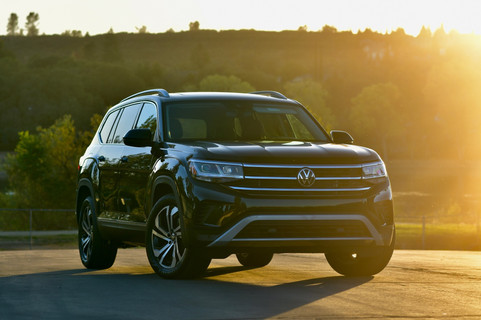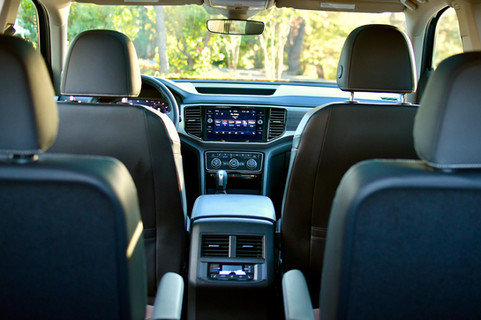2021 Volkswagen Atlas SEL Premium Review and Photos
- Mitchell Weitzman
- Oct 26, 2020
- 7 min read
Updated: Oct 26, 2020

Premium may be in the name, but is it in the game?
Words and Photos by Mitchell Weitzman
It was Saturday, about half past noon, as my next-door neighbor and myself are watching the Petit Le Mans race at Road Atlanta. He had just acquired a massive, 75 inch LG TV. Even as the affordable model, it was mind blowing to watching racing and basically anything on. As it currently sat on the floor, he signals to a large box next to it and asks if I want to help him put together the new TV stand he ordered. However, there was a hiccup: We notice the sticker on the plain cardboard has the description of a "Threshold Bookshelf," which I'm no detective, but that doesn't seem like a tv-stand to me. Open the box, and the label wasn't lying.
Was this defeat? Heck no, not when you have the gargantuan device parked outside known as the Volkswagen Atlas. So he calls around a few Targets and finds the only one of his desired TV-stand in-stock in Lincoln, CA, about 45 minutes away. Why wait a week for returns and shipping? Easily fold down the third-row seats, collapse one of the second-row captain's chairs, and the Atlas easily swallowed the large assembly-required TV stand. Fold down all the seats, and you could likely have fit a dozen.
Yes, the Volkswagen Atlas is enormous, catering exactly to what VW's market research says Americans want, because, you guessed it, the Atlas was made for America. Costco? Green Acres? Camping? A Great Dane and Malamute? Atlas will do it and with room for another binge. Once you climb inside the 200 inch long, three-row SUV, you're immediately aware of the size. Some cars seem to shrink around you on the move, but not the Atlas' substantial sense of mass. Pull alongside a Yaris or Smart and you might capture them in your gravitational pull.

But, step back outside the Atlas, and it's easy to marvel at the sheer beauty of this seemingly simple and boxy shape. It's a great looking ride, especially in the illustrious Racing Green paint that is new for this year, a hue that harkens back to iconic British Racing Green. The 20" wheels are quite nice as well. A box shouldn't look this good, but it does, and it's this boxy silhouette that reaps rewards in maximizing interior space. So far, so good then - it looks great and it's huge, perfect for the American market and the recent craze for SUVs.
But it's all not so rosy. Open the door and you're greeted with what appears to be an upscale interior with classic saddle brown leather seats, but that's it. Climb aboard and it's when your hand first reaches the handle to close it that you notice something is wrong: hard plastic, and not even well-finished hard plastic. I don't mind that the interior looks a decade old, I rather admire simple, clean interiors, but the quality and fit and finish are far behind the current crop of competition. It doesn't help when the window sticker shows a whopping as-tested price of $50,710 for this SEL Premium example.
The simple matter is that there are too much hard plastics littered around the cabin. Even the leather seats fall behind in terms of hide quality. It's almost shocking, and considering how well the exterior looks, the interior becomes downright disappointing. Apart from this revelation, it is bestowed all the latest and greatest tech and safety goodies and features that are prevalent on all new vehicles these days. The single best part of the inside is the humongous and gorgeous panoramic sunroof, making an already large interior feel even more so.
Seating wise, the front seats are comfortable enough, but on the wider side for my small frame. The second-row consisted of separate captain's chairs instead of the usual bench. Great for keeping fighting children apart! Though the leg room is huge, my adult passengers complained of the individual seats being too flat and too small, which I confirmed for myself. Usually captain's chairs area a good way to build more support into them, but while the front seat was too wide, the rear was about too narrow. To fold and go, just pull a handle and tab, and these seats fold completely flat with the rest of the cargo area.
The third-row, however, received no complaints from my adult passenger that picked the shortest straw. Not to to say it's good, but because most third-row seats are absolute slabs of concrete, it was a pleasant surprise. And yes, another quick pull and they're flat and ready for your Ikea trip.
The gauge cluster is an entirely digital creation called Digital Cockpit, which allows for some interesting concepts and information, but it here it's a little too over-the-top; An overload of too much information if you will. With five different steering-wheel buttons to navigate through the data depths, including navigation, it can be too much and even distracting. Luckily, one of the views consists only essentials to relax.

The entertainment system is easy to use, but the screen is tiny next to a Highlander's optional new twelve inch unit. The rear-view camera could be cleaner, but it does at least have the desirable top-view camera. What struck me odd, however, is how you had to press a button marked 'Menu' to access it. This comes across counterintuitive. Really, it should default to displaying both together, which is what the badly titled 'Menu' button then does. I looked and found no way to make this the preferred automatic setting. Up until this point I was amazed at how it didn't even have this camera for the price. It's there, but why is it practically hidden?
VW's Atlas leaves a large footprint on the road, but the way it drove surprised me. At first, I disliked the overly light steering that required just a pinky finger to turn and the sloppiness created from the soft suspension, but I warmed to it over time. Entirely inoffensive, the Atlas is remarkably easy to drive around in even with it feeling massive. The light steering helps disguise the mass, but direct enough to not feel like a 20 year old Suburban. The soft suspension affords great ride quality, but can be a clumsy. A good example are the lasting recoils from larger imperfections as the springs and dampers work overtime to get it settled again.
The biggest surprise was what happens when you drive it a little bit faster around a corner. Start pegging the throttle through a corner, and instead of understeering into a tree, the Atlas somehow seems to almost hunker down and gain composure despite the initial waywardness. The 4Motion all-wheel drive must certainly help, giving the instinct that its there helping pull you through to corner exit. On a looping, tight, freeway onramp, I was amazed at the corner speed available and the willingness of it to charge. Not a sports SUV like a Porsche Macan, but a welcome surprise given the size and purpose of this barge to exhibit such handling balance when pushed.

On the freeway, cruising at just over 70, the Atlas was quiet and extremely competent. No steering corrections were needed as it tracked straight and true. 60 miles to the Dixon corn maze felt like minutes being so easy and relaxing to drive. Long hauls would be no problem, for the driver at least.
Momentum comes from an optional 3.6L V6 with 276 horsepower and 266 pounds of torque, replacing the standard 2.0L turbocharged inline-4. While smooth and often emitting a nice guttural growl, the V6 is outmatched here, burdened by nearly 5,000 pounds. 0-60 MPH took 8 seconds with 50-70 passing needing 4.5. Getting up to speed on freeways required prodigious throttle effort. A lazy 8-speed automatic did no favors either. Though smooth in action, in the standard drive mode, the automatic insisted on shifting up decisively early to the next gear, hindering highway merging. Often, I would have to press the accelerator for more power which just causes it to downshift back to the gear it was just at. Using the sport mode mostly relieves this, but at the expense of economy. For fifty-thousand dollars, though, you have to expect better performance than this.
Speaking of which, the Atlas averaged 19 MPG in my driving and 25 on the highway. While this didn't seem great at first, it is a rather large car so you can't fault it too much. But, a similarly weighty 'entry' BMW X5 with its monumentally faster turbocharged inline-six manages better economy. Maybe VW should try something similar, though with VW AG's growing push to electric propulsion, why pour money to develop another gas-burning unit at this point.
Straddling a dichotomy of good and bad, the Atlas is similar to two tectonic plates fighting each other. On one hand we have this gorgeous shape and a likeable driving experience, but erupting that are underwhelming performance and a clearance-rack interior. And no, it's not the clearance rack at Saks.
We live in a world where people have no problem paying $50,000 for mainstream SUVs, just look at Toyota's Highlander. Volkswagen is supposed to be bringing German prestige to the trenches of this crowded fight, only to be missing that prestige component. With a renewed interior and a few more horsepower, this huge Atlas SEL Premium would be a huge winner, even at its price point.
2021 Volkswagen Atlas SEL Premium 4Motion
As-Test Price $50,710
The Road Beat Rating 3.5/5
Pros: Beautiful sheetmetal, maximized interior space
Cons: Weak performance, cheap interior
Verdict: If looks and size are what matters, the Atlas is it. For prestige and luxury, look elsewhere.
Afterthoughts...Other Atlas models start in the mid-$30,000s, which represents big value for money given the vast size of the Atlas and how much the Atlas can take with you. An SE model with the V6 could well be worth a look.
























































































